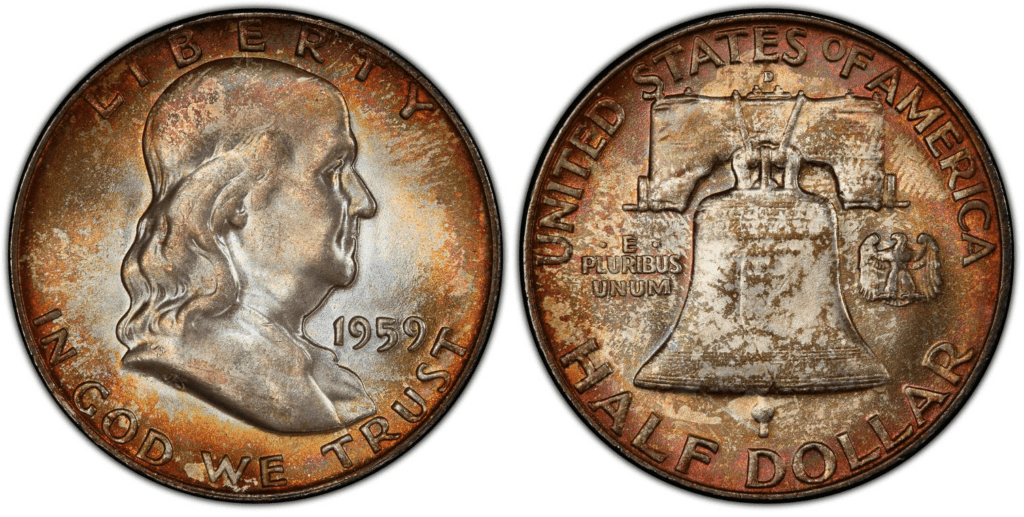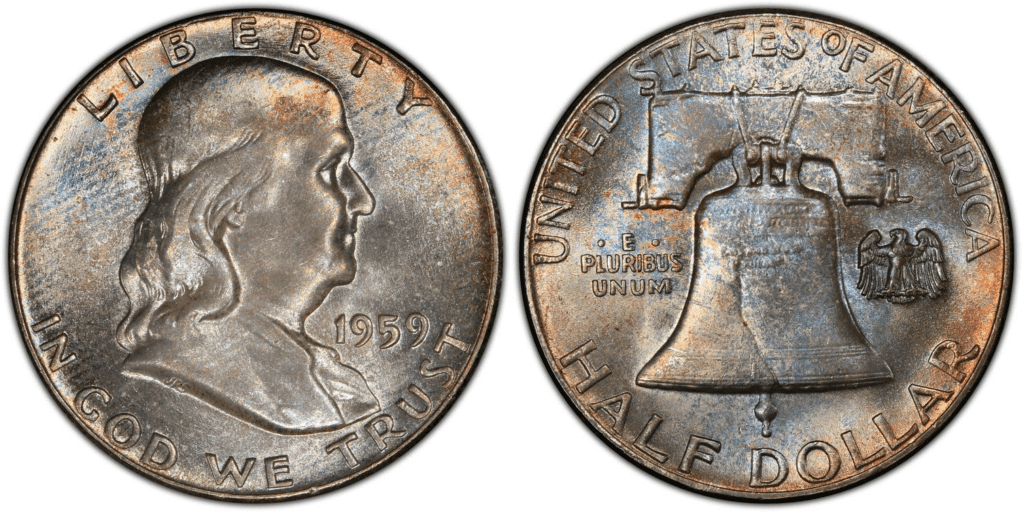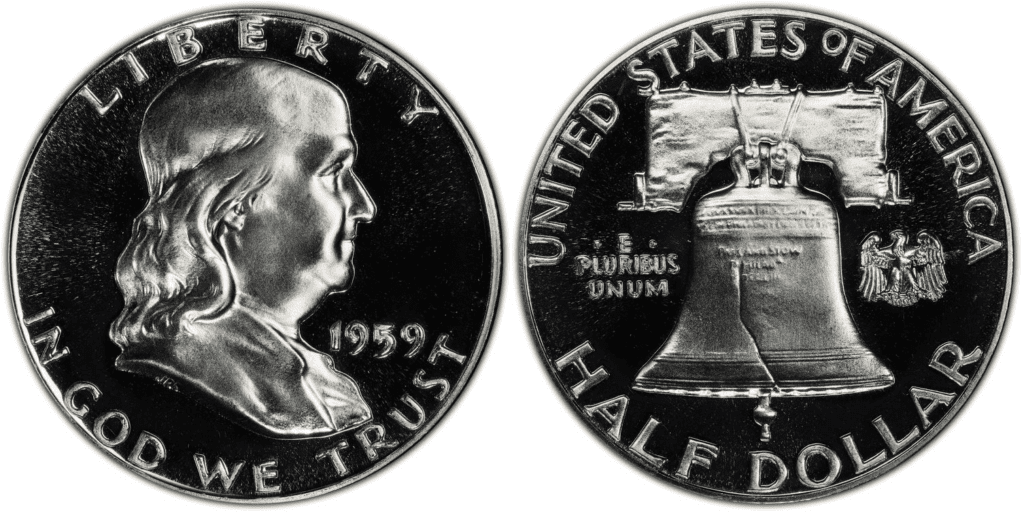What Is the 1959 Franklin Half Dollar Made Of?
The 1959 Franklin half-dollar is made of 90 percent silver and 10 percent copper. Its silver content is equivalent to 0.36169 troy oz. From 1948 to 1963, the half dollar was primarily made of silver, making it a more valuable coin than other coins made in base metals.
To get a general idea of what the 1959 Franklin half dollar is, here are some of its specifications:
- Value – 50 cents
- Mass – 12.50 grams
- Thickness – 1.8 mm
- Edge – reeded
Regarding the design, the obverse features a bust of Benjamin Franklin. He is one of the Founding Fathers of the United States. Inscriptions on the obverse include LIBERTY, IN GOD WE TRUST, AND 1959.

On the reverse, you’ll find the Liberty Bell. Aside from that, a small eagle was included. This was done to fulfill the legal requirement that all half-dollar coins should include a picture of an eagle. Inscriptions include the following:
- UNITED STATES OF AMERICA
- E PLURIBUS UNUM
- HALF DOLLAR
The person who initiated the addition of Franklin on a coin was Nellie Tayloe Ross, the Mint Director who was a great admirer of the late president. She thought of the idea of adding Franklin on a coin after seeing a medal designed by John Sinnock.
While Ross knew that Franklin didn’t like adding portraits on coins and would rather add proverbs, she explained that Franklin would have no problem adding an image of a deceased US founder on the coin.
Thus, on January 7, 1948, the Treasury announced that a new half-dollar design would be released. The Treasury also mentioned that people should use the Franklin coin as a reminder to be thrifty and save money in savings bonds and savings stamps, just like Franklin, who was known for his thriftiness.
John Sinnock designed the Franklin half dollar. The US Mint allows artists to add their initials to the coin they have designed. So, the “JS” was added. However, some people see the initials as a way to mean Joseph Stalin. In response, the Mint changed the initials from JS to JRS. However, this still didn’t stop the rumor.
In 1963, John F. Kennedy was assassinated. Congress moved to add Kennedy’s image to the half-dollar. So, finally, the Franklin half-dollar series ended on December 30, 1963.
1959 Franklin Half Dollar Varieties
The 1959 Franklin half dollar has at least three varieties, which include a proof version. The US Mint that produced the 1959 half-dollar coins were Denver and Philadelphia.
There are also coin errors in the 1959 half-dollar series. This gave rise to a different type of coin.
Here are the 1959 Franklin half-dollar varieties that you should know:
1959 D Franklin Half Dollar
Year of minting: 1959
Mint Mark: D
Place of minting: Denver
Quantity produced: 13,053,750
Face Value: $0.50 (one cent)
Price: $0.50 to $30.00 (or more)
Mass: 12.50 grams
Edge: Reeded
Designer: John Sinnock (with the help of Gilroy Roberts)
Composition: 90% silver and 10% copper
Diameter: 30.00 mm
Thickness: 1.8 mm

The 1959 D half dollar was produced in the Denver Mint. Thus, you’ll find the mint mark “D” on top of the Liberty Bell. At the end of 1959, there were more than 13 million of these coins produced. This made the 1959 D half-dollar the most abundant variety in the 1959 half-dollar series.
You can buy the 1959 D 50-cent coin from $0.50 to $30.00. However, since this is an old coin and it is made of silver, then you can be sure that there are 1959-D half-dollar coins that are more expensive.
1959 P Franklin Half Dollar
Year of minting: 1959
Mint Mark: Absent
Place of minting: Philadelphia
Quantity produced: 6,200,000
Face Value: $0.50 (one cent)
Price: $0.50 to $24.00 (or more)
Mass: 12.50 grams
Edge: Reeded
Designer: John Sinnock (with the help of Gilroy Roberts)
Composition: 90% silver and 10% copper
Diameter: 30.00 mm
Thickness: 1.8 mm

The Philadelphia Mint produced more than 6.2 million of 1959 half-dollar coins. On average, you can buy or sell 1959-P coins for $0.50 to $24.00.
1959 P Franklin Half Dollar (Proof)
Year of minting: 1959
Mint Mark: Absent
Place of minting: Philadelphia
Quantity produced: 1,149,291
Face Value: $0.50 (one cent)
Price: $0.50 to $41.00 (or more)
Mass: 12.50 grams
Edge: Reeded
Designer: John Sinnock (with the help of Gilroy Roberts)
Composition: 90% silver and 10% copper
Diameter: 30.00 mm
Thickness: 1.8 mm

You might have noticed that the Philadelphia Mint only produced about 6.2 million regular coins. One of the reasons is that the Philadelphia Mint also produced proof coins in 1959, which are more difficult and time-consuming to produce.
Today, 1959 50-cent-proof coins are fairly common. There are a lot of coins from this year that are well-preserved. There are even several examples that achieved a grade of up to PR 69 condition. Although, proof coins with a Deep Cameo rating are rarer. The average selling price of 1959 half-dollar coins is $0.50 to $41.
List of 1959 Franklin Half Dollar Errors
In 1959, the US Mint produced 20,403,041 Franklin half-dollar coins. With such a high mintage, it’s not surprising that there would be some coins that would come with errors.
There are different reasons an error may happen. However, the most common would be due to mechanical failure and the wear and tear of the minting equipment. Because of the repeated actions of these machines, some coins won’t properly be minted.
One good example of a 1959 half-dollar coin error is the doubled die strike. This happens when the coin is struck twice, leaving a doubling image. Doubled die strikes can happen on the obverse or reverse. Not all doubled die errors are easy to detect. Some would need a microscope or magnifying glass to find them. However, the more obvious the error is, the more valuable the coin becomes.
Another example of a 1959 half-dollar coin error is the die break error. In this error, the die breaks due to wear and tear. When that happens, the crack also gets imprinted on the coin.
Sometimes, an error happens during the cutting of planchets. The planchet may become clipped or folded. There are also times when a foreign material gets into the mixture of silver and copper. This leads to a lamination error, which is evidenced by cracks, separation, and flakes on the coin.
Die strikes can also be weak, which leads to blurry engraved elements. Die strikes can be off-center due to the misalignment of the die and planchet.
As you can see, there are different errors that happened during the minting process of the 1959 half-dollar. Nevertheless, many coin enthusiasts are more than happy to collect coin errors because they are unique and rare.
How Much Is 1959 Franklin Half Dollar Worth Today?
The 1959 Franklin half dollar is worth 50 cents, just like what its face value suggests. Its melt value is higher since it is made of silver. The melt value is $8.4492.
While you may think that the 1959 Franklin half dollar isn’t that valuable, you will be surprised to know that there are those coins that were sold for hundreds and even thousands of dollars.
Here’s a 1959 Franklin Half Dollar values chart to help you understand its real value:
| Coin | Condition | Grade | Mintage | Value |
| 1959 D Franklin half dollar | Circulated/mint | Not graded | 13,053,750 | $0.50 to $30 |
| 1959 D Franklin half dollar | Uncirculated/mint | MS-64 | 13,053,750 | $17 to $43 |
| 1959 D Franklin half dollar | Uncirculated/mint | MS-65 | 13,053,750 | $21 to $79 |
| 1959 D Franklin half dollar | Uncirculated/mint | MS-66 | 13,053,750 | $312 to $2,160 |
| 1959 P Franklin half dollar | Circulated/mint | Not graded | 6,200,000 | $0.50 to $24.00
|
| 1959 P Franklin half dollar | Uncirculated/mint | MS-65 | 6,200,000 | $24 to $60 |
| 1959 P Franklin half dollar | Uncirculated/mint | MS-66 | 6,200,000 | $229 to $382 |
| 1959 P Franklin half dollar | Uncirculated/mint | MS-67 | 6,200,000 | $990 to $5,060 |
| 1959 P Franklin half dollar (Proof) | Uncirculated/proof | Not graded | 1,149,291 | $0.50 to $41.00
|
| 1959 P Franklin half dollar (Proof) | Uncirculated/proof | PR-67 | 1,149,291 | $45 to $312 |
| 1959 P Franklin half dollar (Proof) | Uncirculated/proof | PR-68 | 1,149,291 | $55 to $240 |
| 1959 P Franklin half dollar (Proof) | Uncirculated/proof | PR-69 | 1,149,291 | $396 to $564 |
As you can see, the 1959 half dollar is valuable. To give you more idea of its value, check out the auction records for the 1959 half dollars listed by PCGS.
For the 1959-D regular strike, the auction record is $7,590. It is a Franklin half-dollar coin with an AU58 grade. Heritage Auctions sold it in January 2006.
For the 1959-P half-dollar, the auction record is $5,060. However, a 1959 50C was sold for $14,688 in August 2018. What made the coin really expensive was its FBL (Full Bell Lines) rating.
For the 1959 Franklin half-dollar proof coin, the auction record goes to a proof coin with a Deep Cameo rating. It was sold for $22,800 by Heritage Auctions in February 2020.
How Does The Grading System Work?
The Sheldon Scale is used by numismatists to provide a numerical value to coins. The Sheldon Scale goes from poor (P-1) to perfect mint state (P-1) (MS-70). Coins were originally evaluated using words to reflect their condition (Good, Fair, Excellent, Etc.). Unfortunately, coin collectors and dealers had different ideas about what each of these terms represent.
Professional numismatists joined together in the 1970s and established CoinGrading standards. These numismatists now assign grades at key places on the seventy-point scale, using the most regularly utilized numeric points in conjunction with the original adjective grade. The following are the most common coin grades:
-
-
- (P-1) Poor – Indistinguishable and probably damaged; if used, must have a date and mintmark; otherwise, rather battered.
- (FR-2) Fair – Nearly smooth, but without the damage that a coin graded Poor often possesses. The coin must have enough detail to be identified.
- (G-4) Fair – Inscriptions have merged into the rims in some areas, and important elements have been mostly erased.
- (VG-8) Very Good- A little weathered, but all of the primary design elements are visible, albeit faintly. There is little if any, central detail left.
- (F-12) Good – The item is very worn, yet the wear is even, and the overall design details stand out clearly. Rims are almost completely isolated from the field.
- (VF-20) Very Fine – Moderately weathered, with some finer features still visible. The motto or all letters of LIBERTY are readable. Both sides of the coin have entire rims that are separated from the field.
- (EF-40) Extremely Fine – Gently used; all gadgets are visible, and the most important ones are bold. The finer details are bold and clear, however, light wear may be seen.
- (AU-50) Uncirculated – Slight evidence of wear on the coin’s design’s high points; may have contact marks; eye appeal should be adequate.
- (AU-58) Uncirculated Choice – Slight traces of wear, no severe contact marks, almost full mint shine, and great eye appeal.
- (MS-60) Mint State Basal – Strictly uncirculated; no indication of wear on the coin’s highest points, but an unsightly coin with reduced luster, visible contact marks, hairlines, and other flaws.
- (MS-63) Mint State Acceptable – Uncirculated, but with contact scratches and nicks, little reduced shine, but otherwise appealing appearance. The strike is weak to average.
- (MS-65) Mint State Choice – Uncirculated with great mint shine, very little contact blemishes, and exceptional eye appeal. The strike is unusually severe.
- (MS-68) Mint State Premium Quality – Uncirculated with superb luster, no obvious contact marks to the naked eye, and exceptional eye appeal. The strike is quick and appealing.
- (MS-69) Almost Perfect Mint State – Uncirculated with perfect brilliance, a sharp and appealing strike, and extremely good eye appeal. A near-perfect coin with minor imperfections in the planchet, strike, and contact markings (seen only under 8x magnification).
- (MS-70) Mint State Perfect – Under 8x magnification, there are no tiny imperfections discernible; the strike is crisp, and the coin is perfectly centered on a beautiful planchet. Rarely seen on a coin, this coin is bright and whole, with original luster and exceptional eye appeal.
-
Where To Buy Or Sell 1959 Franklin Half Dollar?
The 1959 Franklin half dollar coin is available on Amazon, eBay, and other online selling platforms. The Internet is a quick and easy place to find the coin you want. Of course, be extra careful. Aside from not seeing the actual coin, you must also be wary of scammers. Be sure to only transact with trusted and reputable vendors.
Aside from the Internet, you can buy or sell 1959 50-cent coins in coin shops, antique stores, collectors, pawnshops, and auctions.
FAQs
Where is the mint mark on a Franklin Half Dollar?
The minty mark on a Franklin half dollar is found on the reverse side of the coin. Look above the yoke of the bell. You should see the mint mark under the letter “E” of the word “STATES.” Please note that the only mint mark you would find is D if the coin is from Denver. The Philadelphia Mint doesn’t add mint marks on the coins they produce.
How much is the 1959 Franklin Half Dollar with a doubled die error?
The 1959 Franklin half dollar with a doubled die error can be a few tens to hundreds of dollars. If the coin is still in beautiful condition, the value can easily go up to a thousand dollars.
How many Franklin half dollars were minted by the Denver Mint?
The Denver Mint produced around 10 to 20 million Franklin half dollars every year. So, from 1948 to 1963, the Denver Mint could have produced hundreds of millions of Franklin half dollars.
